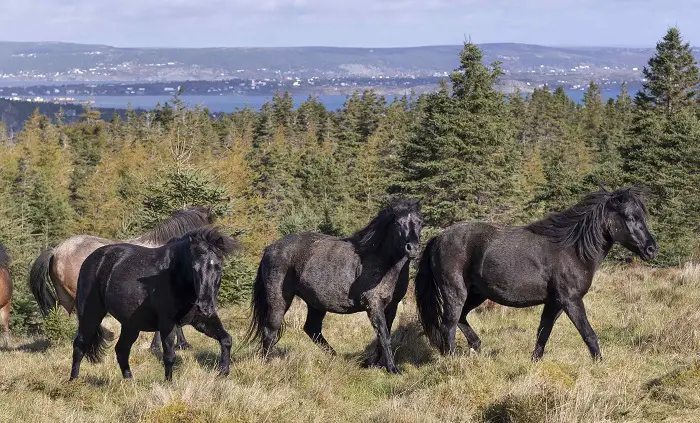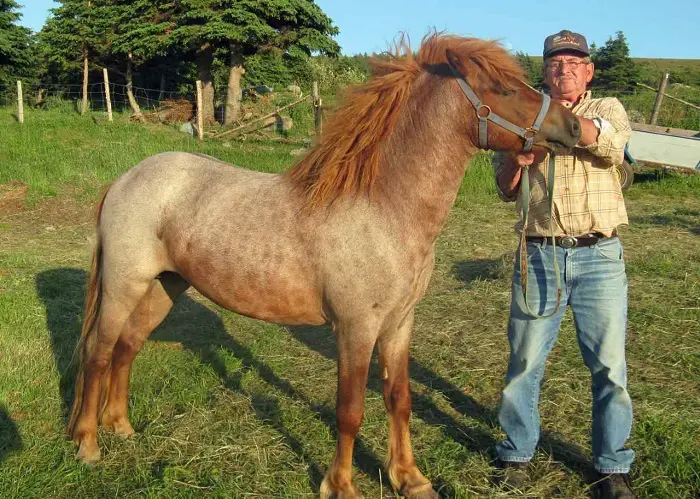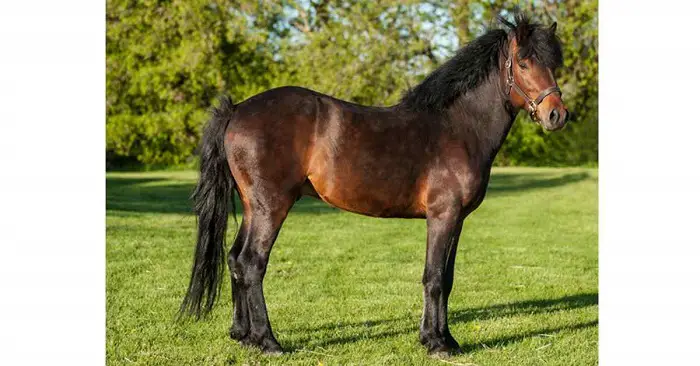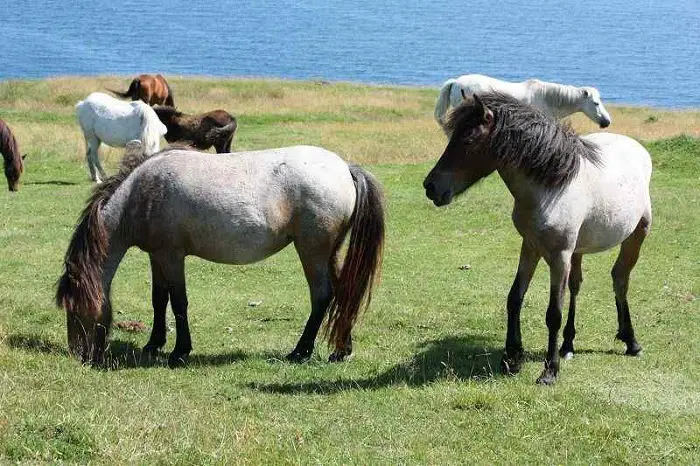The Newfoundland Pony is a small, hardy horse breed originating in Newfoundland, Canada. This breed has a rich history played a vital role in developing Newfoundland’s culture and economy.
The Newfoundland Pony’s ancestry can be traced back to the horses brought to Newfoundland by European settlers in the 17th century. These horses were primarily used for work in the fields, for transportation, and as a means of livelihood for the island’s inhabitants. Over time, a distinct population of ponies evolved in Newfoundland’s challenging and isolated environment.
Origin and History of Newfoundland Pony
The origin and history of the Newfoundland Pony can be traced back to the 17th century, when European settlers first arrived in Newfoundland, Canada. These settlers brought horses to the island primarily for agricultural work, transportation, and logging.
The horses that arrived in Newfoundland were likely a mix of various breeds, including those from the British Isles, such as the Dartmoor, Exmoor, and Connemara ponies, as well as French and Spanish breeds. Over time, a distinct population of ponies developed in Newfoundland due to the isolated and harsh conditions of the region. These ponies adapted to the island’s rugged terrain, extreme weather, and limited resources.
The Newfoundland Pony was crucial in developing Newfoundland’s economy and culture. They were used extensively in logging operations, hauling heavy loads of timber through dense forests. Their strength, agility, and sure-footedness suited them well for this demanding work.
In addition to logging, Newfoundland Ponies were employed in various other tasks. They were used for plowing fields, pulling carts and sleds, transporting goods and people, and even riding ponies for children. Their versatility and endurance made them indispensable to the daily lives of Newfoundlanders.
However, with the advent of modern machinery and transportation in the 20th century, the demand for working ponies declined rapidly. Tractors and trucks replaced the need for horses in agriculture and transportation, and the population of Newfoundland Ponies began to decline.
The Newfoundland Pony faced further challenges during the economic crisis of the Great Depression in the 1930s. Many ponies were turned loose or sold as their owners could no longer able to care for them. Additionally, the Canadian government introduced a bounty program to reduce the number of ponies on the island, further contributing to the breed’s decline.
By the 1970s, the Newfoundland Pony was on the verge of extinction. It is estimated that there were only 100 ponies remaining. Recognizing the historical and cultural significance of the breed, efforts were made to preserve and protect them.
The Newfoundland Pony Society (now known as the Newfoundland Pony Conservancy) was established in 1979. The society focused on breeding programs, promoting the breed’s value, and educating the public about the importance of the Newfoundland Pony. The ponies were declared a Heritage Animal under the Newfoundland Pony Act in 1997, providing legal protection and recognition for the breed.
Since then, dedicated breeders and enthusiasts have worked tirelessly to increase the population of Newfoundland Ponies. The numbers have slowly increased through careful breeding practices and conservation efforts, but the breed remains rare and endangered.
Today, the Newfoundland ponies serve as a symbol of Newfoundland’s cultural heritage and the resilience of its people. It represents a bridge to the past and a reminder of these ponies’ vital role in shaping the island’s history. Efforts to preserve and protect the breed continue, ensuring that future generations can appreciate and learn from the unique heritage of the Newfoundland Pony.
Physical Features of Newfoundland Pony
The Newfoundland Pony is a small, sturdy breed known for its distinctive physical features. Here are some of the notable characteristics:
- Size: The Newfoundland Pony is considered a small breed, typically standing between 11 to 14 hands high (44 to 56 inches or 112 to 142 cm) at the withers. They are considered ponies rather than horses due to their height.
- Body: The breed has a compact, muscular build with a well-rounded barrel. Their broad chest, short back, and muscular, sloping shoulders contribute to their strength and endurance.
- Head: Newfoundland Ponies have a refined head with a straight or slightly convex profile. They often have large, expressive eyes and alert ears. The head is well-set on a muscular neck, adding to their balance and elegance.
- Coat: The Newfoundland Pony has a thick, double-layered coat that helps them withstand the harsh weather conditions of Newfoundland. The outer coat is coarse and dense, while the undercoat is soft and insulating. This coat allows them to stay warm and dry even in cold and wet environments. The breed comes in various coat colors: bay, black, gray, and chestnut. White markings on the face and legs are standard.
- Mane, Tail, and Feathers: Newfoundland Ponies typically have long, flowing manes and tails that enhance their appearance. Their manes and tails are often thick and abundant, adding to their visual appeal. Some individuals may also exhibit feathering, which refers to long hair on the lower legs, particularly around the fetlocks.
- Hooves: The breed is known for its solid and well-formed hooves, adapted to Newfoundland’s rugged terrain. The hooves are typically dense and durable, allowing the ponies to navigate challenging landscapes easily.
- Height and Weight: As mentioned earlier, Newfoundland Ponies range in height from 11 to 14 hands. Depending on their size and build, they typically weigh between 400 to 700 kilograms (880 to 1,540 pounds).
Overall, the physical features of the Newfoundland Pony reflect its heritage as a hardy and resilient breed that thrived in the demanding conditions of Newfoundland. These features contribute to their strength, agility, and suitability for various tasks, whether pulling heavy loads or navigating rough terrains.
Height and Weight of Newfoundland Pony
The Newfoundland Pony is a small breed, with heights typically ranging from 11 to 14 hands (44 to 56 inches or 112 to 142 cm) at the withers. As ponies, they are shorter in stature compared to horses.
Regarding weight, Newfoundland Ponies generally weigh between 400 to 700 kilograms (880 to 1,540 pounds). The weight can vary based on the pony’s size, build, and overall condition.
It’s important to note that there can be some variation within the breed, as individual ponies may fall outside the typical height and weight ranges. These figures provide a general guideline for the size of Newfoundland Ponies but may not be exact for everyone.
Color and Markings of Newfoundland Ponies
The Newfoundland Pony displays a variety of colors and markings. Here are some of the standard colors and markings found in the breed:
- Solid Colors: Newfoundland Ponies can come in solid colors such as bay, black, chestnut, and gray. The Bay is reddish-brown with black points (mane, tail, and lower legs). Black is solid, while chestnut ranges from light to dark reddish-brown. Gray can vary from a light gray to a dark charcoal color.
- White Markings: Many Newfoundland Ponies have white markings on their faces and legs. These markings can include stars, snips, blazes, and various combinations. Some ponies may also have white socks or stockings on their legs.
- Roan: Roan is another color pattern seen in Newfoundland Ponies. Roan ponies have a mixture of white and colored hairs evenly distributed throughout their coat, giving them a “frosted” or speckled appearance.
- Tobiano: Tobiano is a typical coat pattern in the breed. Large, rounded patches of white and solid-colored hair characterize it. The white patches usually extend downward from the top line and cross over the back, contrasting with the base color.
- Overo: Overo is another coat pattern occasionally seen in Newfoundland Ponies. Overo patterns tend to have irregular, scattered patches of white with jagged edges. The base color shows through the white areas, and the white patches do not cross the back.
It’s important to note that while these colors and markings are commonly seen in Newfoundland Ponies, individual variations can occur within the breed. Some ponies may exhibit unique or less common color patterns not mentioned here. The breed’s diverse coat colors and markings add to its visual appeal and individuality.
Behavior and Temperament Newfoundland Ponies
The Newfoundland Pony is known for its gentle temperament, hardworking nature, and adaptability. Here are some critical aspects of their behavior and temperament:
- Versatility: Newfoundland Ponies are versatile and can excel in various equestrian disciplines. They have been historically used for work, such as pulling carts and sleds and logging operations. Today, they participate in driving, riding, and even therapy programs due to their calm and patient demeanor.
- Docile and Gentle: Newfoundland Ponies are typically docile, gentle, and easy to handle. They have a kind disposition and are known for their willingness to work with their handlers. This temperament makes them suitable for children and novice riders.
- Endurance and Strength: The breed’s history of hard work in challenging conditions has endowed them with remarkable endurance and strength. They can navigate rough terrains and sustain physical exertion for extended periods.
- Intelligence: Newfoundland Ponies are considered intelligent and quick to learn. They are responsive to training and can understand and follow commands well. Their intelligence, combined with their willingness to please, makes them trainable and adaptable to various tasks.
- Social Nature: Newfoundland Ponies are generally sociable animals that enjoy the association of humans and other horses. They often form good relations with their owners and are known for their loyalty.
- Resilience: The breed’s ability to survive in Newfoundland’s harsh and demanding environment has instilled resilience in the Newfoundland Pony. They are hardy and adaptable, capable of withstanding challenging weather conditions and minimal resources.
- Sensible and Sure-Footed: Newfoundland Ponies possess a sensible nature and are known for their sure-footedness. They have an inherent ability to navigate rugged terrains with confidence and stability.
It’s important to note that individual temperaments can vary within the breed, as factors such as training, handling, and socialization can influence an individual pony’s behavior. However, the general characteristics described above represent the typical behavior and temperament of the Newfoundland Pony.
Feed and Nutrition of Newfoundland Pony
The feed and nutrition requirements of Newfoundland Ponies are similar to those of other horse breeds, with considerations for their size, activity level, and overall health. Here are some important aspects to keep in mind when it comes to feeding and nutrition for Newfoundland Ponies:
- Forage: Forage forms the foundation of a Newfoundland Pony’s diet. They require access to high-quality pasture, hay, or both. Good-quality grass hay is typically the primary forage source and should be provided to meet their daily roughage needs.
- Pasture Management: Newfoundland Ponies can benefit from grazing on well-maintained pastures. Pastures should be free from toxic plants and regularly rotated to prevent overgrazing and maintain optimal nutrition.
- Concentrates: Depending on the pony’s activity level, age, and body condition, additional concentrates may be required. Commercially formulated feeds, such as pellets or textured grains, can provide additional calories, protein, vitamins, and minerals. Selecting feeds explicitly designed for ponies is essential to avoid excess energy intake.
- Balancing Nutritional Requirements: Newfoundland Ponies should receive a well-balanced diet that meets their nutritional needs. This includes appropriate protein, carbohydrates, fats, vitamins, and minerals. Consulting with a veterinarian or equine nutritionist can help determine the specific nutritional requirements of individual ponies.
- Adequate Water: Access to fresh and clean water is essential for proper digestion, hydration, and overall health. Ensure that Newfoundland Ponies can access clean water through buckets, troughs, or automatic waterers.
- Body Condition Monitoring: Regularly monitor Newfoundland Ponies’ body condition to ensure they maintain a healthy weight. Adjust their feed intake accordingly to prevent underweight or overweight conditions. Consult with a vet or equine nutritionist for proper guidance on body condition scoring and appropriate feeding adjustments.
- Supplements: In some cases, Newfoundland Ponies may require additional supplements to address specific nutritional needs or deficiencies. These supplements should be recommended by a veterinarian or equine nutritionist based on individual requirements and should be given with professional guidance.
It’s important to note that Newfoundland Ponies’ feeding and nutritional requirements can vary depending on age, workload, health conditions, and individual metabolism. Regular monitoring, professional guidance, and adjustments to the feeding program as needed will help ensure these ponies’ overall health and well-being.
Health and Care of Newfoundland Pony
The health and care of Newfoundland Ponies are essential for their overall well-being. Here are some key aspects to consider when it comes to their health and care:
- Regular Veterinary Care: Ensure Newfoundland Ponies receive routine veterinary care, including vaccinations, deworming, dental examinations, and general health check-ups. Regular veterinary visits help identify and address any health issues promptly.
- Proper Nutrition: Provide a well-balanced diet consisting of high-quality forage (pasture and hay) and, if necessary, concentrates specifically formulated for ponies. Monitor their body condition and adjust their feed intake accordingly. Consult with a vet or equine nutritionist for specific dietary recommendations.
- Water and Hydration: Ensure access to clean, fresh water. Adequate hydration is essential for overall health, fitness, and proper bodily functions.
- Exercise and Mental Stimulation: Engage Newfoundland Ponies in regular exercise to maintain their physical fitness. Regular turnout and daily exercise routines help prevent obesity, improve muscle tone, and provide mental stimulation.
- Hoof Care: Regular hoof care is essential for the well-being of Newfoundland Ponies. This includes routine trimming and, if necessary, shoeing by a professional farrier. Regular hoof care helps prevent hoof-related issues and ensures proper gait and soundness.
- Parasite Control: Implement a regular deworming program recommended by a veterinarian to control internal parasites. Conduct fecal egg counts to monitor parasite load and adjust deworming protocols accordingly.
- Shelter and Protection: Provide adequate shelter to protect Newfoundland Ponies from extreme weather conditions, such as excessive heat, cold, rain, or snow. The shelter should offer protection from wind, rain, and direct sunlight.
- Grooming: Regular grooming helps maintain the cleanliness of the pony’s coat, skin, and hooves. It also allows for early detection of skin issues, wounds, or abnormalities. Grooming also helps foster a bond between the pony and its handler.
- Vaccinations and Preventive Measures: Follow a veterinarian’s recommendations for vaccination protocols to protect Newfoundland Ponies against common equine diseases. Additionally, implement preventive measures such as regular dental care, proper hoof management, and environmental hygiene to minimize health risks.
- Social Interaction: Newfoundland Ponies are social animals and benefit from regular human interaction and companionship. Social interaction, mental stimulation, and appropriate socialization with other horses can improve their overall well-being.
Regular monitoring, attention to detail, and early intervention in case of health issues are crucial to maintaining the health and well-being of Newfoundland Ponies. Consulting with a veterinarian and other equine professionals will help ensure optimal care for these ponies.
Specific Diseases of Newfoundland Pony
Like all horse breeds, Newfoundland Ponies are susceptible to various diseases and health conditions. Here are some specific diseases and conditions that can affect Newfoundland Ponies:
- Equine Metabolic Syndrome (EMS): EMS is a metabolic disorder that can result in obesity, insulin resistance, and an increased risk of laminitis. Newfoundland Ponies may have a higher predisposition to EMS than other pony breeds.
- Laminitis: Laminitis is a painful and potentially debilitating condition that affects the hoof laminae, leading to lameness. Newfoundland Ponies, especially those prone to obesity or metabolic disorders, may be at an increased risk of laminitis.
- Cushing’s Disease (PPID): Pituitary Pars Intermedia Dysfunction (PPID), commonly known as Cushing’s disease, is a hormonal disorder that affects older horses. Newfoundland Ponies can be susceptible to this condition, which can cause symptoms such as abnormal hair growth, weight loss, increased thirst and urination, and laminitis.
- Dental Issues: Newfoundland Ponies, like all horses, can develop dental problems such as dental caries, periodontal disease, and malocclusions. Regular dental examinations and floating (filing down sharp edges of teeth) are necessary to maintain proper dental health.
- Parasitic Infections: Newfoundland Ponies can be affected by internal and external parasites, including worms, ticks, and mites. Regular deworming protocols, parasite monitoring, and proper pasture management are essential to control parasitic infections.
- Respiratory Conditions: Newfoundland Ponies can be susceptible to respiratory diseases such as equine asthma (formerly known as recurrent airway obstruction or heaves) and respiratory infections. Proper ventilation, good stable management practices, and minimizing exposure to dusty environments can help prevent respiratory issues.
- Skin Conditions: Newfoundland Ponies may be prone to skin conditions like rain rot, sweet itch, and allergies. Regular grooming, appropriate turnout, and proper management of the environment can help prevent and manage these conditions.
It’s important to note that this list is not exhaustive, and other diseases and conditions may affect Newfoundland ponies. Regular veterinary care, preventive measures, and prompt attention to any signs of illness or discomfort are essential in maintaining the health and well-being of these ponies.
Is the Newfoundland Pony endangered?
Yes, the Newfoundland Pony is considered an endangered breed. The breed’s population has declined significantly, threatening its survival. Several factors have contributed to its endangered status:
- Changing Agricultural Practices: The traditional role of the Newfoundland Pony as a working and transportation animal diminished with modern machinery and transportation methods. As a result, the demand for Newfoundland Ponies decreased, leading to a decline in their population.
- Loss of Habitat: With the decline in traditional agricultural practices, suitable grazing land and habitats for the Newfoundland Pony have diminished. Encroachment of human development and changing land use patterns have further limited their access to appropriate grazing areas.
- Lack of Conservation Efforts: For many years, there needed to be more recognition of the breed’s importance and efforts to preserve and promote it. This lack of attention and conservation initiatives further declined the breed.
- Small Population Size: The remaining population of Newfoundland Ponies is relatively tiny, further exacerbating the risk of genetic bottlenecks and inbreeding. A small population size increases the breed’s vulnerability to genetic disorders and reduces its overall genetic diversity.
- Rarity and Lack of Awareness: The Newfoundland Pony is relatively unknown outside of its native region, which has hindered efforts to increase awareness and support for its conservation.
Despite their endangered status, there have been concerted efforts by individuals, organizations, and government bodies to conserve and protect the Newfoundland Pony. Conservation programs, breed registries, breeding initiatives, and public awareness campaigns have been launched to increase the breed’s population and preserve its genetic diversity.
These efforts aim to raise awareness about the breed’s historical and cultural significance, promote its versatility, and create sustainable breeding programs. By doing so, these initiatives strive to ensure the long-term survival and conservation of the Newfoundland Pony.
Uses of Newfoundland Pony
The Newfoundland Pony has a rich history of serving various purposes, and while its traditional roles have diminished, the breed still possesses versatility and can be used in different ways. Here are some common uses of the Newfoundland Pony:
- Recreational Riding: Newfoundland Ponies can be ridden for leisure and recreational purposes. Their gentle temperament and comfortable gaits make them suitable for riders of various skill levels, including children and novice riders.
- Driving and Carriage Work: Newfoundland Ponies have a history of being used for driving and pulling carriages. They are solid and capable of pulling loads, making them suitable for pleasure driving, light carriage work, or even participating in driving competitions.
- Therapy and Assistance Programs: Their calm, patient nature and manageable size make Newfoundland Ponies well-suited for therapy and assistance programs. They can provide emotional support, companionship, and therapeutic benefits to individuals with physical, cognitive, or emotional challenges.
- Conservation Grazing: Due to their ability to thrive on marginal grazing land and their grazing habits, Newfoundland Ponies can be utilized for conservation grazing. They can help maintain and restore natural habitats by grazing on vegetation and preventing the growth of invasive plant species.
- Cultural and Heritage Events: Newfoundland Ponies play a significant role in preserving the cultural heritage and traditions of the region. They are showcased in various cultural events, parades, and exhibitions, providing a connection to the history and heritage of Newfoundland and Labrador.
- Educational Programs: Newfoundland Ponies can be valuable educational resources, particularly in teaching children about horsemanship, animal care, and the importance of conservation. They can be used in educational programs and interactive experiences to promote learning and appreciation for these unique equines.
It’s important to note that while the Newfoundland Pony can still serve these purposes, their numbers are limited, and efforts are being made to promote their use and ensure their long-term viability. The versatility and adaptability of the breed make it a valuable resource in different contexts, allowing it to continue contributing to various aspects of equestrian and cultural activities.
Concluding Remarks on Newfoundland Pony
The Newfoundland Pony is significant in Newfoundland and Labrador’s history, culture, and heritage. Despite facing numerous challenges and being classified as an endangered breed, efforts are being made to preserve and protect these remarkable ponies.
Known for their strength, resilience, and gentle temperament, Newfoundland Ponies have historically been versatile working animals. They have pulled carts, cultivated fields, and transported goods in challenging terrains. Their adaptability and willingness to work make them suitable for various equestrian activities, including recreational riding, driving, therapy programs, and conservation grazing.
Beyond their practical uses, Newfoundland Ponies embody a connection to the past and serve as ambassadors of cultural heritage. They are treasured for preserving traditions, participating in cultural events, and educating people about the importance of conservation and historical significance.
Conservation efforts, breed registries, and public awareness campaigns are crucial in safeguarding the future of the Newfoundland Pony. By promoting responsible breeding, raising awareness about their value, and providing support for their continued use, we can ensure the preservation of this unique and cherished breed for generations to come.
The Newfoundland Pony represents not only a living link to the past but also a symbol of resilience, adaptability, and the spirit of the people of Newfoundland and Labrador. By recognizing their significance and taking collective action, we can help secure a promising future for these remarkable ponies and celebrate their role in our shared history.




